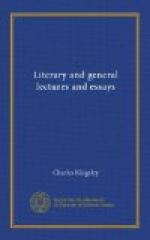Or, again, in a passage which has been already often quoted as exquisite, and in its way is so:
The bridegroom sea
Is toying with the shore, his wedded bride;
And in the fulness of his marriage joy
He decorates her tawny brow with shells,
Retires a pace, to see how fair she looks,
Then proud, runs up to kiss her.
Exquisite? Yes; but only exquisitely pretty. It is untrue—a false explanation of the rush and recoil of the waves. We learn nothing by these lines; we gain no fresh analogy between the physical and the spiritual world, not even between two different parts of the physical world. If the poetry of this age has a peculiar mission, it is to declare that such an analogy exists throughout the two worlds; then let poetry declare it. Let it set forth a real intercommunion between man and nature, grounded on a communion between man and God, who made nature. Let it accept nature’s laws as the laws of God. Truth, scientific truth, is the only real beauty. “Let God be true, and every man a liar.”
Now, be it remembered that by far the greater proportion of this book consists of such thoughts as these; and that these are what are called its beauties; these are what young poets try more and more daily to invent—conceits, false analogies. Be it remembered, that the affectation of such conceits has always marked the decay and approaching death of a reigning school of poetry; that when, for instance, the primeval forest of the Elizabethan poets dwindled down into a barren scrub of Vaughans, and Cowleys, and Herberts, and Crashawes, this was the very form in which the deadly blight appeared. In vain did the poetasters,




